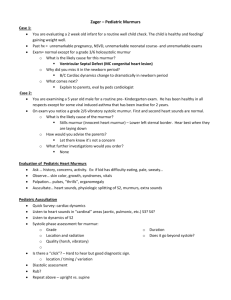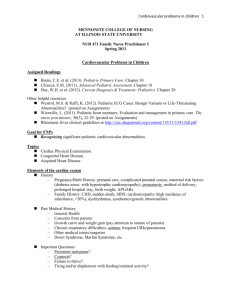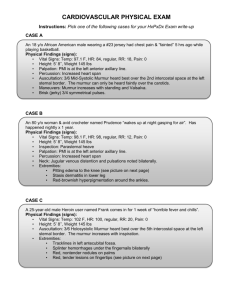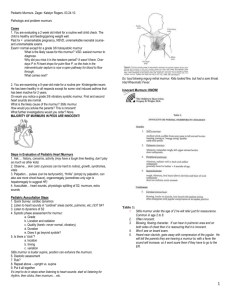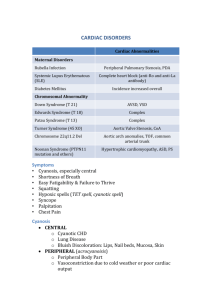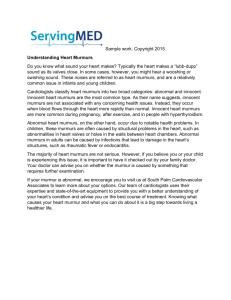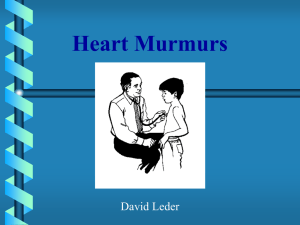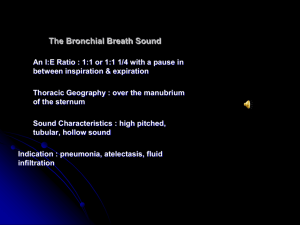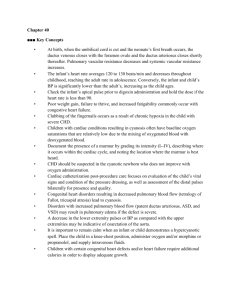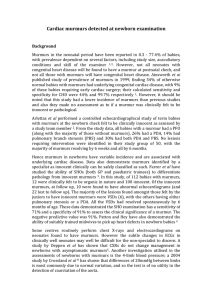Ryan Parnham, MSN, APN, CNP
advertisement
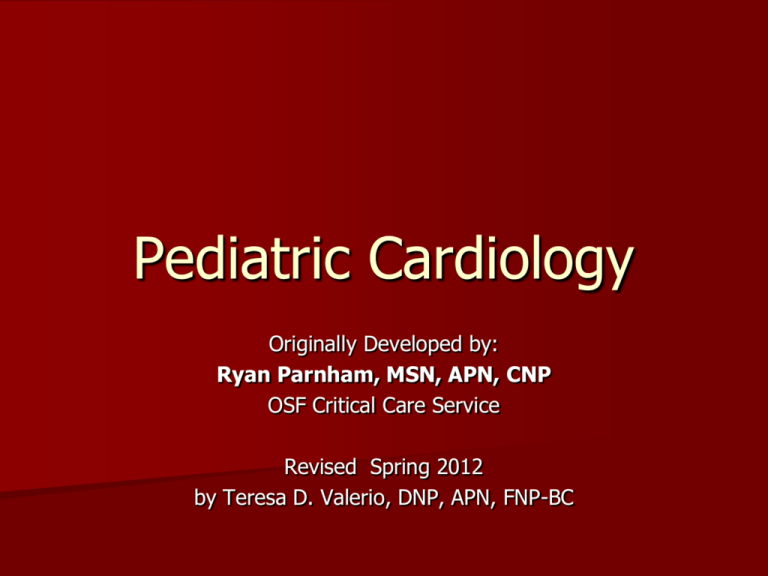
Pediatric Cardiology Originally Developed by: Ryan Parnham, MSN, APN, CNP OSF Critical Care Service Revised Spring 2012 by Teresa D. Valerio, DNP, APN, FNP-BC Today’s Topics Cardiac Physical Examination Congenital Heart Disease Acquired Heart Disease Purpose Enhance knowledge and confidence with pediatric cardiology Emphasize the importance of recognizing significant pediatric cardiovascular abnormalities as a primary care provider Readings from Textbooks Burns, C.E. et al. (2009). Pediatric Primary Care. – Chapter 30, pgs. 727-766. Chiocca, E.M. (2011). Advanced Pediatric Assessment. – Chapter 18, pgs. 366-390. Hay, W.H. et al. (2011). Current Diagnosis & Treatment: Pediatrics. – Chapter 19, pgs. 536-541, 547-566, 571- 582, 593-594. Other helpful resources Westrol, M.S. & Raffi, K. (2012). Pediatric ECG Cases: Benign Variants or Life-Threatening Abnormalities? (PDF emailed) Wierwille, L. (2011). Pediatric heart murmurs: Evaluation and management in primary care. The nurse practitioner, 36(3), 22-29. (PDF emailed) Rheumatic fever clinical guidelines at http://www.indianpediatrics.net/pdf/acute_rheu matic_fever.pdf Elements of the cardiac physical examination History Pregnancy/Birth History: prenatal care, complicated prenatal course, maternal risk factors (diabetes assoc. with hypertrophic cardiomyopathy), prematurity, method of delivery, prolonged hospital stay, birth weight, APGARs Family History: CHD, sudden death, SIDS, cardiomyopathy (high incidence of inheritance, >20%), dysrhythmias, syndromes/genetic abnormalities Past Medical History General Health Concerns from parents Growth curve and weight gain (pay attention to stature of parents) Chronic respiratory difficulties- asthma, frequent URIs/pneumonia Other medical issues/surgeries Down Syndrome, Marfan Syndrome, etc. Important Questions Persistent tachypnea? Cyanosis? Failure to thrive? Tiring and/or diaphoresis with feeding/minimal activity? Palpitations? Chest Pain with exertion? Syncope/Near-syncope? Syncope with exertion? Palpitations with syncope? Lethargy/Fatigue? Inability to keep up with peers? Worsening activity tolerance? Vital Signs Respiratory Rate- should be counted for a full minute in infants because of variability Heart rate- resting if possible Blood pressure- bilateral upper and lower extremities (at least once in their life, unless more often if clinically indicated)use correct size cuff! Pulse ox- check/recheck multiple extremities if abnormal reading Overall Appearance Anxious, distressed, diaphoretic, pale, tachypneic, retractions, cyanotic, difficult to console, dysmorphic, clubbing A baby, child and adolescent can have a significant cardiac lesion and appear perfectly healthy with apparently normal vitals signs Cardiovascular Assessment Is chest symmetrical? Evidence of pectus excavatum, pectus carinatum. Precordial activity quiet or hyperactive? PMI displaced? (usually mid-clavicular line) Palpable thrill over chest? Thrill at suprasternal notch? JVD? Auscultation Listen at all landmarks (aortic, pulmonic, 2nd pulmonic, tricuspid, mitral) with bell and diaphragm Listen to heart sounds S1: closure of what valves? S2: closure of what valves? S1 Closure of the atrioventricular valves (mitral and tricuspid) Normally heard as one sound, although occasionally splitting may be heard S2 Closure of the semilunar valves (pulmonary and aortic) Under normal circumstances, S2 is “split” during or near the end of inspiration (the right ventricle is filled more than the left with inspiration, causing a short delay in closure of the PV) A fixed or widely split S2 could be pathologic, as can a single S2 that does not split. www.med.ucla.edu/wilkes/inex.htm Murmurs What is a heart murmur? Murmurs Murmurs are audible sound waves caused by turbulent blood flow- a murmur is not a hole, or a defective valve, etc. Most murmurs are “innocent,” or Still’s murmurs, 32-80% of all children will have a murmur at some point in their life, often with fever Structural or physiologic cardiac problems can also cause murmurs; 1% of children have structural heart disease Grading of Murmurs 1: Heard only with intense concentration 2: Faint, but heard immediately 3: Easily heard, of intermediate intensity 4: Easily heard and palpable thrill present 5: Very loud, thrill present, and audible with edge of stethoscope on chest wall 6: Audible with stethoscope off chest wall Innocent Vibratory Murmur or Still’s Murmur Most common during childhood Low to medium pitch, early systole Usually grade 2, but can range 1-3 Maximal at LLSB w/ radiation to apex Usually loudest supine and fades with sitting and standing Vibratory, harmonic, musical Often louder during febrile illness or times of increased cardiac output Usually disappear with time and can come and go Innocent Pulmonary Flow Murmur A relatively soft systolic murmur appreciated at the upper left sternal border Often louder while lying supine and fades/disappears with sitting Venous Hum Continuous murmur usually heard at the infraclavicular area of the anterior chest, R>L Loudest while sitting (venous return from the jugular veins and subclavian veins entering the SVC ) and disappears supine Can be diminished or muted with gentle compression of jugular vein Commonly associated with vibratory murmur Pathological Systolic Murmurs Upper Right Sternal Border: Aortic Stenosis, subaortic membrance, PPAS Upper Left Sternal Border: Pulmonary Stenosis, PDA, PPAS Mid to Lower Left Sternal Border: VSD, TR, LVOT narrowing (HCM)/Subaortic stenosis Apex: MR, poss VSD Pathological Systolic Murmurs Usually don’t change with position, except HCM causing LVOT obstruction becomes louder with standing. MR may be somewhat more pronounced while lying on the left side. Often times “harsh”, usually quite different from an innocent murmur, but not always Diastolic Murmurs Always pathological- there are no “normal” or “innocent” diastolic murmurs What are some diastolic murmurs? “Early” Diastolic Murmurs Decrescendo in nature Commonly aortic regurgitation or pulmonary regurgitation (insufficiency) Mid to Late Diastolic Murmurs Tricuspid stenosis or mitral stenosis Continuous Murmurs Heard through systole and diastole- most common “pathological” continuous murmur is a Patent Ductus Arteriosus Cardiovascular Exam (cont’d) Resp- Lungs clear? Equal? Congested? Diminished? Tachypneic? Retractions? Skin- Warm? Pink? Well-perfused? Abdomen- soft? Liver enlarged? Ascites? Situs solititus or inversus? Pulses- Weak? Bounding? Normal? Brachial/radial-femoral delay? Extremities: Capillary Refill Brisk? Clubbing? Edema? Exam (con’t) If you want to truly perform a quality cardiovascular examination, auscultate the patient lying, sitting, standing and squatting, especially with athletes, patients with syncope with exertion, or family history of sudden death and/or hypertrophic cardiomyopathy! When Do You Refer for a Murmur? Is this a new murmur? What are the characteristics of the murmur? Systolic vs. diastolic. Is the child febrile? Is the child “symptomatic”? What testing has been done thus farEKG, CXR, ECHO Family history When Do You Refer for a Murmur? If no definite “red flags,” consider having the child RTC to re-listen in a week or two (especially if febrile!!!) If some concern, order an EKG and CXR- relatively inexpensive and can provide useful info If EKG and CXR normal, but still uncertain, ok to refer or consider ordering an echo (caution- expensive and may “over-diagnose”) If child in obvious distress- refer immediately/admit for evaluation If the patient is in competitive athletics and it is a new murmur, consider referral. At least order an EKG and CXR prior to referralappreciated by the cardiology group! Congenital Heart Disease Congenital Heart Disease 8-10/ 1,000 liveborn infants will have a congenital cardiac malformation (0.8-1%) Risk of recurrence in families with one parent or one sibling with CHD is 1-4% Some defects are associated with even higher recurrence rates in families, and geneticists are beginning to identify certain genes that may help explain this What causes CHD? Genetic factors? Environmental factors? Genetic and environmental factors? Possible environmental factors: maternal infection/illness, medication use, substance abuse, chronic diseases such as diabetes, lupus, etc. Review of Fetal Circulation Congenital Cardiac Lesions Acyanotic and Cyanotic Acyanotic Lesions Atrial Septal Defect (ASD) Ventricular Septal Defect (VSD) Atrioventricular Septal Defects/AV Canal Patent Ductus Arteriosus (PDA) Aortic Stenosis Pulmonary Stenosis Coarctation of the Aorta Cyanotic Lesions d-transposition of the great arteries (d-TGA) Tetralogy of Fallot Hypoplastic right heart syndrome Hypoplastic left heart syndrome Double outlet right ventricle (DORV) Truncus arteriosus Total anomalous pulmonary venous return (TAPVR) Commonly Seen Acyanotic Lesions Atrial Septal Defects (ASD) Common defect May be a PFO/small secundum ASD- 20-25% of the population has this May be larger, causing significant L to R shunting Can go undetected for years Exam: wide, fixed splitting of S2, often a systolic murmur r/t increased pulm flow “Easily” fixed (surgery vs. transcatheter) Ventricular Septal Defect Ventricular septum fails to “fill in” completely during embryonic development Various degrees of VSDs from tiny to large May be asymptomatic, mildly symptomatic, or in congestive heart failure May not present clinically until 1-2 months of life Often associated with other lesions Isolated VSD’s typically have favorable surgical outcomes Many small and even mod sized VSD’s can close spontaneously for up to 4 years of age Mitral Valve Prolapse The most common valvular abnormality (2-6% of the population)- more common in females than males (2:1) Usually benign, but may also have mitral regurgitation Can worsen with time, or improve Exam: mid-late systolic click (often), blowing, holosystolic murmur if significant degree of MR Diagnosis- echocardiogram (often wrongly and overdiagnosed by exam only) May be associated with connective tissue disorders such as Marfan Syndrome Coarctation of the Aorta Narrowed area of the aorta (usually descending or transverse arch) May cause hypertension Often systolic murmur LUSB with radiation to left back Discrepancy between upper and lower extremity blood pressure and pulses Usually an “easy” repair Common Cyanotic Lesions Tetralogy of Fallot 4 defining characteristics- Pulmonary stenosis, RVH, VSD, and aortic override May be associated with a genetic syndrome Surgical repair in first year of life (often need a shunt placed soon after birth) If PV is replaced, usually have some degree of dysfunction that needs to be monitored over time D-transposition of the Great Arteries Aorta rises from the RV and Pulmonary Artery rises from the LV- complete separation of pulmonary and systemic circulations Arterial switch procedure There are many advances underway in pediatric cardiac surgery and cardiac catheterization techniques that are not only improving surgical outcomes, but resulting in shorter hospital stays and a better quality of life. Acquired Heart Disease Kawasaki Disease (KD) An acute, self-limited vasculitis Unknown cause, but an infectious cause/virus is suspected Leading cause of acquired heart disease in US and Japan Usually seen in children <5 y.o. First described by Dr. Kawasaki in Japan, 1961 KD- Diagnostic Criteria Fever >/= 5 days Bilateral conjuctival injection Changes of mucous membranes- injected pharynx, fissured lips, strawberry tongue Changes of peripheral extremities- peripheral edema, peripheral erythema, desquamation of palms Polymorphous rash Cervical adenopathy Diagnosis is presence of fever and 4 of 5 remaining criteria KD- Cardiovascular concerns Development of coronary artery aneurysms (usually around 2 wks after onset of symptoms) Evaluated by echocardiogram Half of patients with aneurysms will remodel vessel wall- never completely normal. Probably at higher risk for future coronary artery diseaselong-term antiplatelet therapy generally recommended Strawberry Tongue Treatment Standard treatment is high-dose IVIG (immunoglobulins) in combination with high doses of aspirin Screening/repeat echocardiograms Possible cardiac cath with intervention if coronary artery aneurysms causing myocardial dysfunction or for further evaluation Long-term prognosis without coronary aneurysm No significant risk of increased mortality Possible increased risk of premature atherosclerosis r/t vasculitis? Little long-term data, although there have been a couple of studies suggesting abnormal vasodilatory properties of coronary arteries in KD patients with seemingly “unaffected” coronaries Rheumatic Fever A systemic illness thought to occur following group A beta hemolytic streptococcal pharyngitis (GABHS) in children, median age 10 years (can happen in adults though) Although uncommon in present day, accurate clinical diagnosis is vital for optimal long-term prognosis. Was the leading cause of death in patients aged 5-20 in the US about 100 yrs ago. Increased risk- untreated or delayed treatment of a strep infection History Sore throat 1-5 wks prior to onset of RF symptoms Fever, rash, headache, wt loss, fatigue, diaphoresis, chest pain/pounding, migratory joint pain, skin nodules, motor dysfunction, previous RF (higher risk of recurrence) Can cause endocarditis, myocarditis, and pericarditis. Usually affecting the mitral and aortic valves resulting in regurgitation Jones Criteria Requires presence of 2 major, or 1 major and 2 minor criteria. Previous Group A strep is also necessary Major Criteria Carditis (EKG, CXR, ECHO, Exam)- new murmur and tachycardia. Wide pulse pressure if severe aortic regurgitation. May also have CHF- JVD, hepatomegaly, gallop rhythm, friction rub, peripheral edema Polyarthritis Chorea- brief, irregular, unpredictable, purposeless movements that flow from one body part to another without a rhythmic pattern Erythema marginatum- 1 to 3 cm pink/red nonpruitic macules or papules on trunk and limbs (not on face) Subcutaneous nodules- infrequent, but occur on surfaces of elbows, knees, ankles, knuckles, and other spinous processes- firm and nontender Subcutaneous Nodules Erythema Marginatum Minor Criteria Fever- usually greater than 39 deg C, although may be low-grade, may last 2-3 weeks Arthralgia- cannot be considered minor if arthritis is present Prolonged PR interval in EKG Elevated erythrocyte sedimentation rate (ESR) and C-Reactive Protein (CRP) Evidence of GAS pharyngitis – one of the following MUST be present Positive throat culture or rapid strep antigen test Elevated or rising streptococcal antibody titer (such as antistreptolysin O [ASO]) Lab Studies Throat culture Rapid antigen detection test Antistreptococcal antibodies- usually using antistreptolysin O (ASO) C-RP, ESR Imaging CXR- pulm cong/CHF Echo- MR, AR, LV dilation ECG- sinus tachy, 1st, 2nd or 3rd degree AV block (myocarditis), ST segment elevation, atrial arrhythmias Treatment Antibiotics- Oral penicillin remains drug of choicealternatives: IM Pen G, E-mycin, 1st gen Cephalosporin (do not use tetracyclines or sulfonamides) High dose aspirin and steroid to treat inflammation (cont to monitor C-RP and ESR for effectiveness) Digoxin, diuretics, afterload reduction depending on cardiac manifestations After acute phase symptoms have subsided, improved, may undergo cardiac surgery for valve repair/replacement- if AV and/or MV replaced with prosthetic, will require lifetime anticoagulation (Warfarin) What does this mean as FNP’s Recognizing and treating streptococcal infections in a timely manner Awareness of potential systemic symptoms related to untreated/delayed treatment of a strep infection- these may not occur until up to several weeks after the sore throat has resolved Only infections of the pharynx initiate RF (in developed countries) Secondary prophylaxis of patients with history of RF- daily PCN or injections q 3-4 wks SBE prophylaxis with antibiotics prior to dental and other procedures Revised AHA guidelines for Bacterial Endocarditis Prevention Previous guidelines recommended antibiotics prior to dental/surgical procedures for anyone with any type of intracardiac abnormality (MVP, bicuspid AV, etc) Recent findings- bactremia is transient and can occur with routine activities (brushing teeth, flossing, chewing) Only “high-risk” patients are recommended to have antibiotic SBE prophylaxis “High risk” population includes: Prosthetic heart valves Previous endocarditis Unrepaired cyanotic defect Palliative shunt/conduit present Complete repair with prosthetic material for first 6 months after procedure Heart transplantation Recommended only for procedures which manipulates the tissue or oral mucosa causing bleeding, etc. (not a routing cleaning) Those not in “high risk” category are not at zero riskstill slightly elevated compared to those without intracardiac abnormalities Other common complaints Chest pain- rarely attributed to any underlying cardiovascular disease. Coronary artery abnormalities in children rarely present with chest pain Syncope- very common in adolescents and teenagers. Usually vasovagally mediated and r/t hydration, eating habits, etc. “Red flags”syncope during strenuous activity, accompanied with palpitations, family history of sudden death or arrhythmias
